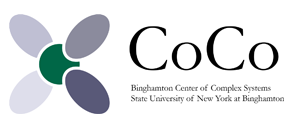Author ORCID Identifier
0000-0002-9564-2529
Abstract
Moving animal groups such as schools of fish and flocks of birds frequently switch between different group structures. Standard models of collective motion have been used successfully to explain how stable groups form via local interactions between individuals, but they are typically unable to produce groups that exhibit spontaneous switching. We are only aware of one model, constructed for barred flagtail fish that are known to rely on alignment and attraction to organize their collective motion, that has been shown to generate this type of behavior in 2D (or 3D). Interestingly, another species of fish, golden shiners, do exhibit switching but have been shown to use attraction and repulsion, not alignment, to coordinate themselves in schools. Suggesting that switching may be explained by attraction and repulsion alone, without an alignment interaction. Here we introduce a model based on attraction and repulsion only and show that groups exhibiting switching similar to that observed in experiments with golden shiners emerges. We also establish that switching occur in two boundary-free extensions of the model. Our work suggests that the bistability and switching behavior observed in golden shiners and other moving animal groups may be explained via attractive and repulsive interactions alone.
Recommended Citation
Strömbom, Daniel; Nickerson, Stephanie; Futterman, Catherine; DiFazio, Alyssa; Costello, Cameron; and Tunstrøm, Kolbjørn
(2022)
"Bistability and Switching Behavior in Moving Animal Groups,"
Northeast Journal of Complex Systems (NEJCS): Vol. 4
:
No.
1
, Article 1.
DOI: https://doi.org/10.22191/nejcs/vol4/iss1/1
Available at:
https://orb.binghamton.edu/nejcs/vol4/iss1/1
Included in
Behavior and Ethology Commons, Biology Commons, Non-linear Dynamics Commons, Numerical Analysis and Computation Commons, Organizational Behavior and Theory Commons, Systems and Communications Commons

